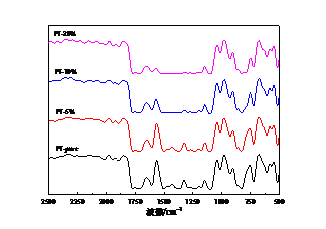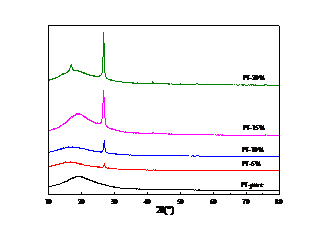高导热聚酰亚胺复合材料的合成及摩擦学性能研究毕业论文
2020-07-02 22:57:44
摘 要
本文通过原位聚合法,以均苯四甲酸二酐(PMDA)、4,4’-二氨基二苯醚(ODA)、二甲基乙酰胺(DMAc)和石墨型氮化硼(h-BN)为原料合成具有较高导热系数的聚酰亚胺复合材料。并采用傅里叶红外仪、X射线衍射仪对其结构和组成进行研究,采用导热仪研究材料的导热系数,采用电子万能试验机研究材料的力学性能,采用摩擦磨损试验机研究材料的摩擦学性能。结果表明,通过在聚酰亚胺基体中引入氮化硼(BN)可以明显提高复合材料的力学性能、导热性能和摩擦学性能,当氮化硼含量10%时,复合材料的各项性能达到最优。
关键词:聚酰亚胺 导热 氮化硼 摩擦磨损
ABSTRACT
In this paper, polyimide composites with high thermal conductivity were synthesized by the method of in situ polymerization using dianhydride (PMDA), 4,4 '- two amino two benzoethers (ODA), two methyl acetamide (DMAc) and graphite boron nitride (h-BN) as raw materials. The structure and composition of the materials were studied by Fourier transform infrared (FTIR) and X-ray diffractometer. The thermal conductivity of the materials was studied by the thermal conductivity meter. The mechanical properties of the materials were studied by the electronic universal testing machine. The tribological properties of the materials were studied by the friction and wear testing machine. The results show that the mechanical properties, thermal conductivity and Tribological Properties of the composites can be greatly improved by introducing boron nitride (BN) into the polyimide matrix. When the boron nitride content is 10%, the properties of the composites are optimal.
KEYWORDS: Polyimide ;Thermal conductivity ;Boron nitride ;Friction and wear
目 录
摘要.............................................................................................................I
ABSTRACT..............................................................................................II
目录.............................................................................................................i
- 文献综述......................................................................................1
1.1课题背景..........................................................................................................1
1.1.1摩擦学研究意义...................................................................................1
1.1.2摩擦材料的发展和应用.......................................................................2
1.2高分子聚合物材料的摩擦学研究..................................................................3
1.2.1聚合物摩擦材料的摩擦机理...............................................................3
1.3聚酰亚胺及其复合材料..................................................................................4
1.3.1聚酰亚胺概述.......................................................................................4
1.3.2聚酰亚胺的应用...................................................................................5
1.4聚酰亚胺摩擦学性能改性..............................................................................5
1.4.1填料改性...............................................................................................5
1.4.2基材改性...............................................................................................6
1.4.3协同改性...............................................................................................6
1.5聚酰亚胺摩擦学性能......................................................................................6
1.5.1转速与载荷...........................................................................................6
1.5.2温度.......................................................................................................7
1.5.3环境与工况...........................................................................................7
1.6本文研究的目的和意义..................................................................................7
第二章 实验部分......................................................................................9
2.1 实验部分.........................................................................................................9
2.1.1原料及试剂...........................................................................................9
2.1.2实验设备及仪器...................................................................................9
2.2 实验流程.......................................................................................................10
第三章 实验结果与讨论.........................................................................11
3.1 PI复合材料的红外分析................................................................................11
3.2 PI复合材料薄膜的XRD分析.......................................................................11
3.3 PI复合材料薄膜的导热性能分析................................................................12
3.4 PI复合材料薄膜的力学性能分析................................................................13
3.5 PI复合材料薄膜的摩擦学性能分析............................................................13
第四章 结论.............................................................................................15
参考文献...................................................................................................16
致谢...........................................................................................................18
相关图片展示:






您可能感兴趣的文章
- 用于甲醇制烯烃反应的SAPO-34/ZSM-5复合催化剂的原位水热结晶合成外文翻译资料
- 硫化氢在活体的化学发光探针成像外文翻译资料
- 全色发射型ESIPT荧光团对某些酸及其共轭碱负离子识别的颜色变化外文翻译资料
- 一种用于成像神经元细胞和海马组织中NMDA受体附近内源性ONOO-的双光子荧光探针外文翻译资料
- 表面功能化的Ui0-66/pebax基超薄复合中控纤维气体分离膜外文翻译资料
- 金属有机框架中的可逆调节对本二酚/醌反应:固态固定化分子开关外文翻译资料
- 二维MXene薄片的尺寸相关物理和电化学性质外文翻译资料
- 将制甲烷的Co催化剂转化为产甲醇的In@Co催化剂外文翻译资料
- MXene分子筛膜用于高效气体分离外文翻译资料
- 模板导向合成具有排列通道和增强药物有效荷载的立方环糊精聚合物外文翻译资料




